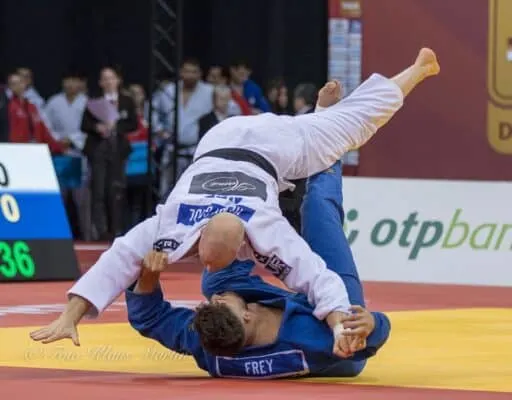
Many Judoka are seen throwing or pinning their opponent to win a match. It can sometimes be unclear whether or not Judo includes submissions in its syllabus. Contrary to popular belief, Judo does have submission moves according to their Judo syllabus.
The Judo syllabus teaches submissions, including choke-holds(without neck cranking) and joint locks. However, most people won’t notice there are submissions because Judo’s primary emphasis is on techniques that involve throwing your opponent to the ground to win the match.
I have provided a more detailed look into Judo submissions below, including a comprehensive list of permitted techniques. I have also explored illegal techniques and made comparisons with BJJ, including which would be better in a self-defense situation.
How Is Judo Different Than Other Martial Arts?
Judo is one of few martial arts that uses your opponent’s strength and momentum against them, instead of relying on your own strength. This is where Judo received its name, which means ‘the gentle way’. This is similar to Jujutsu, which means ‘the gentle art’.
Even though Jujutsu uses the same principles and shares similar techniques, Judo can still be distinguished by its unique syllabus. Judo specifically involves throws, pins, elbow locks and choke-holds. Among the many techniques used in Judo, there are three main categories of techniques, listed below.
- Throwing techniques (Nage Waza)
- Grappling techniques (Katame Waza)
- Striking techniques (Atemi Waza)
Although there is ground grappling involved in Judo, it is mostly distinguished by the use of standing grappling and throws. This is also one key point of difference between Judo and its close relative, Brazilian Jiu-Jitsu. In Judo, the most points (an ‘ippon’) are awarded for successfully throwing your opponent to the ground.
Does Judo Teach Submissions?
The Judo syllabus teaches submissions, including choke-holds and joint locks. However, submissions are not as popular in competitions for a number of reasons.
In a Judo competition, the referee will stop the fight and reset to a standing position if they believe there has been no progress for 5-10 seconds. Most of the time, a submission will take time to establish control and get into the right position. This makes it seem like the fight is not progressing.
Fighting for a submission also expends a lot of energy. Most Judoka prefer to save their energy for their throws. A well-executed throw awards the Judoka an ‘ippon’, which means they automatically win the match.
Because submissions are not as popular as throws in Judo, the student syllabus will focus more on throws and grappling than on submitting your opponent.
Does Judo Have Groundwork?
Groundwork in Judo is known as ‘Ne Waza’, and is taught to all Judoka. Regardless of whether you prefer standing and using throws, every Judoka will find themselves on the ground at some point in their Judo career. Learning to fight for control on the ground is therefore important.
However, most Judoka prefer not to take their fights to the ground because it is harder to earn an ‘ippon’ on the ground. An ippon is awarded for either throwing your opponent to the ground, pinning them for 20 seconds, or submitting them with a choke or elbow-lock.
It is also very easy to reach a stalemate in Ne Waza. As I mentioned earlier, the referee in Judo will reset the match if they believe there has been 5-10 seconds of no progress. This leads to much of the groundwork in Judo being reset to a standing position.
Despite Ne Waza being unpopular in Judo, a Judoka that does not understand these techniques leaves themselves vulnerable to being submitted or pinned on the ground. It is therefore important to at least be able to defend yourself on the ground.
What Submissions Are Allowed In Judo?
As I mentioned earlier, submissions that are permitted in Judo include choke-holds and joint locks. More specifically, only joint-locks involving the elbow are permitted and chokes can only be performed if the neck is not cranked.
Below is a list of variations of an armlock that are permitted in a Judo competition. These attack the elbow, but can sometimes put pressure on the shoulder as well. Any arm lock that only twists the shoulder and not the elbow, such as the ‘chicken wing’ technique, is not permitted.
- Ude Garami (Bent Arm Lock)
- Ashi Gatame (Leg Arm Lock)
- Ude Hishigi Te Gatame (Hand Arm Lock)
- Ude Hishigi Sankaku Gatame (Three Corner Arm Lock)
- Ude Hishigi Juji Gatame (Cross Arm Lock)
- Ude Hishigi Ude Gatame (Straight Arm Lock)
- Ude Hishigi Hara Gatame (Stomach Arm Lock)
- Ude Hishigi Waki Gatame (Armpit Arm Lock)
- Ude Hishigi Hiza Gatame (Knee Arm Lock)
The Ude Garami is one example of an armlock that affects both the elbow and the shoulder. Variations of this technique include the ‘Kimura’ and ‘Americana’ submissions. Because it can be seen as a technique that locks the elbow, this is permitted in Judo.
Chokes (‘Jime’) can block either blood flow or your opponent’s airways until they submit or lose consciousness. You can use both the Judogi or your limbs to choke your opponent. Below is a list of different chokes seen in Judo.
- Sankaku Jime (Triangle Choke)
- Hadaka Jime (Rear Naked Choke)
- Kata Te Jime (One Hand Choke)
- Ryo Te Jime (Two Hand Choke)
- Juji Jime (Cross Chokes – normal, reverse or half)
- Kata Ha Jime (Single Wing Choke)
- Okuri Eri Jime (Sliding Lapel Choke)
- Sode Guruma Jime (Sleeve Wheel Choke)
- Tsukkomi Jime (Thrust Choke)
As you can see, there are a number of different chokes that are permitted in Judo. As long as the opponent’s spinal column and neck are in no danger, such as when the neck is cranked, the choke is permitted.
As an example, a triangle choke is only allowed if the Judoka does not pull down on their opponent’s head to create more pressure. The Guillotine Choke, on the other hand, is usually not allowed because this puts too much pressure on your opponent’s neck, potentially injuring their spine. However, some more lenient referees may allow it.
What BJJ Submissions Are Allowed In Judo?
Based on the lists mentioned above, below are a number of BJJ submissions that are permitted in Judo.
- Arm Bar
- Americana
- Kimura
- Omoplata
- Reverse Omoplata
- Straight Armlock
- Triangle
- Rear Naked Choke
- Ezekial Choke
- Lapel Chokes (such as the Bow and Arrow)
Are There Any Judo Techniques That Are Illegal In BJJ?
Judo is more strict than BJJ when it comes to prohibiting certain techniques, mainly because it has been more regulated to prevent injury. Therefore many BJJ techniques are illegal in Judo, whereas there are very few Judo techniques that are illegal in BJJ.
The Judo techniques that are illegal in BJJ are throws. This is because it is illegal to throw an opponent onto their head or neck in BJJ. There are two throws in Judo, the Ure Nage (Suplex) and Hikikomi Gaeshi, where the head or neck hitting the mat is a byproduct of the throw.
Under the IBJJF rules, any throw where the opponent is thrown onto their head or neck is prohibited. Under the IJF rules, there is an exception if a throw is attempted and the head defense is involuntary, which is the case in the throws mentioned above.
Does Judo Have Strikes?
Striking techniques are part of the Judo curriculum, known as ‘Atemi Waza’. However, these are not allowed in competition and are only practiced in practice drills (Kata). They are also not allowed in free sparring (Randori).
These striking techniques are taught as part of self-defense training. There are many techniques in Atemi Waza, including various strikes to your opponent’s body using the arms and legs.
Which Is Better For Self-Defense Judo Or BJJ?
There are arguments for both Judo and BJJ being the better martial art in a self-defense situation. Judo is more of a balanced martial art, teaching students how to fight standing and on the ground, as well as how to take down your opponent. This prepares people for any situation they might find themselves when attacked.
BJJ, on the other hand, focuses heavily on ground fighting. This means if the fight is still standing, there are not many techniques to draw on to attack, or defend against, your opponent. This is why most BJJ practitioners will pull guard (sit on the ground) or wait for the perfect opportunity to take their opponent to the ground before engaging in the fight.
A small study showed that around 72% of fights end up on the ground, either from falling or being deliberately taken to the ground. This statistic supports the use of BJJ techniques to defend yourself in a street fight because you are more experienced in ground fighting than a Judoka. However, if there are multiple opponents or your opponent is able to get up and use a weapon, BJJ techniques are limited for self-defense.
It is therefore ideal to learn a combination of Judo and BJJ techniques to prepare yourself for any situation, knowing that most fights will end on the ground but some may remain standing. If you needed to choose between the two, Judo provides you with more opportunities to control your opponent (takedowns and throws as well as grappling and submissions)
Choosing between BJJ and Judo can be challenging because they seem similar. However, this article BJJ vs Judo – Key Differences and Core Similarities can definitely help you choose which art is right for you.
Can You Double Leg Takedown In Judo?
The Double Leg was originally recognized as a Judo takedown, known as the Morote Gari. However, as of 2014, the IJF no longer allows these takedowns in competitions. This means that it can still be taught in Judo, but is not as popular because it can only be used outside of competitions, such as in a self-defense situation.
